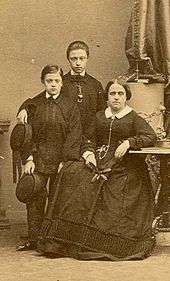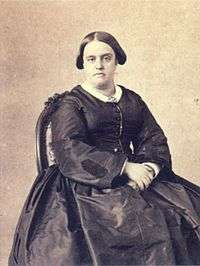Princess Januária of Brazil
| Princess Januária | |||||
|---|---|---|---|---|---|
| Countess of Aquila | |||||
|
Dona Januária at age 43, 1865 | |||||
| Princess Imperial of Brazil | |||||
| Tenure | 30 October 1835 – 23 February 1845 | ||||
| Born |
11 March 1822 Palace of São Cristóvão, Rio de Janeiro, Kingdom of Brazil | ||||
| Died |
13 March 1901 (aged 79) Nice, France | ||||
| Spouse | Prince Louis, Count of Aquila | ||||
| Issue |
Prince Luigi, Count of Roccaguglielma Princess Maria Isabella Prince Filippo Prince Maria Emanuele | ||||
| |||||
| House | Braganza | ||||
| Father | Pedro I of Brazil | ||||
| Mother | Maria Leopoldina of Austria | ||||
| Religion | Roman Catholic | ||||
Princess Januária of Brazil (Portuguese pronunciation: [ʒɐnuˈaɾiɐ mɐˈɾiɐ]; Januária Maria Joana Carlota Leopoldina Cândida Francisca Xavier de Paula Micaela Gabriela Rafaela Gonzaga;[1] 11 March 1822 – 13 March 1901) was a Brazilian princess and Portuguese infanta (princess). She was the second daughter of Pedro I of Brazil and IV of Portugal and his wife Maria Leopoldina, Archduchess of Austria.[1]
Background
Januária was born at the Imperial Palace in Rio de Janeiro a Brazilian princess and Infanta of Portugal.
Heiress and marriage
From 1835 until 1845, she held the title Princess Imperial of Brazil, as the heir presumptive of her brother Emperor Pedro II.[1] When her sister Maria was excluded from the Brazilian line of succession by law no. 91 of 30 October 1835, Januária became heir presumptive to the throne of the Empire of Brazil. Her younger brother Emperor Pedro II was then a minor, and consideration was given to declaring her Regent, though this never materialized. As only a Brazilian member of the Imperial house could inherit the throne, it became critically important for marriages to be arranged for Januária Maria, Pedro II, and their sister Francisca.[2]
Spouses for both Januária and Pedro II were found in the Kingdom of the Two Sicilies. Her marriage to Prince Louis of the Two Sicilies, Count of Aquila (brother of Pedro II's new wife, Empress Teresa Cristina) was celebrated on 28 April 1844 in Rio de Janeiro, Brazil.[1] Her husband was a son of Francis I of the Two Sicilies and his second wife Maria Isabella of Spain.[1] Friction developed between the Count of Aquila and the Emperor, and Januária Maria and Aquila were eventually permitted to leave Brazil in October 1844. In 1845, Januária Maria's position as heir presumptive, and the restrictions it entailed, was lost with the birth of Pedro II's first child, Afonso, Prince Imperial of Brazil.[3]
The city of Januária in Minas Gerais was named in her honor. She died in Nice in 1901.
Children

Januária and Louis had four children:
- Prince Luigi, Count of Roccaguglielma (18 July 1845 – 27 November 1909). Luigi married morganatically Maria Amelia Bellow-Hamel and had two children.
- Princess Maria Isabella of the Two Sicilies (22 July 1846 – 14 February 1859)
- Prince Filippo of the Two Sicilies (12 August 1847 – 9 July 1922). Filippo also married morganatically Flora Boonen and had no children.
- Prince Maria Emanuele of the Two Sicilies (24 January 1851 – 26 January 1851).
Titles and styles
- 11 March 1822 – 12 October 1822: Her Highness Infanta Januária of Portugal
- 12 October 1822 – 30 October 1835: Her Highness Princess Januária of Brazil, Infanta of Portugal
- 30 October 1835 – 28 April 1844 Her Imperial Highness The Princess Imperial of Brazil[1]
- 28 April 1844 – 23 February 1845 Her Imperial Highness The Princess Imperial of Brazil, The Countess of Aquila
- 23 February 1845 – 5 March 1897: Her Royal Highness The Countess of Aquila
- 5 March 1897 – 13 March 1901: Her Royal Highness The Dowager Countess of Aquila
Ancestry
| Ancestors of Princess Januária of Brazil | ||||||||||||||||||||||||||||||||||||||||||||||||||||||||||||||||||||||||||||||||||||||||||||||||||||||||||||||||||||||||||||||||||||||||||||||||||||||||||||||||||||||||||||||||||||||||||||||||||||||||||||||||||||||||||||||||||||||||||||||||||||||||||||||||||||||||||||||||||||||||||||||||||||||||||||||||||||||||||||||||||||||||||||||||||||||||||||||||||||||||||||||||||||||||||||||||||||||||||||||||||||||||||||||||||||||||||||||||||||||||||||||||||||||||||||||||||||||||||||||||||||||||||||||||||||||||||||||||||
|---|---|---|---|---|---|---|---|---|---|---|---|---|---|---|---|---|---|---|---|---|---|---|---|---|---|---|---|---|---|---|---|---|---|---|---|---|---|---|---|---|---|---|---|---|---|---|---|---|---|---|---|---|---|---|---|---|---|---|---|---|---|---|---|---|---|---|---|---|---|---|---|---|---|---|---|---|---|---|---|---|---|---|---|---|---|---|---|---|---|---|---|---|---|---|---|---|---|---|---|---|---|---|---|---|---|---|---|---|---|---|---|---|---|---|---|---|---|---|---|---|---|---|---|---|---|---|---|---|---|---|---|---|---|---|---|---|---|---|---|---|---|---|---|---|---|---|---|---|---|---|---|---|---|---|---|---|---|---|---|---|---|---|---|---|---|---|---|---|---|---|---|---|---|---|---|---|---|---|---|---|---|---|---|---|---|---|---|---|---|---|---|---|---|---|---|---|---|---|---|---|---|---|---|---|---|---|---|---|---|---|---|---|---|---|---|---|---|---|---|---|---|---|---|---|---|---|---|---|---|---|---|---|---|---|---|---|---|---|---|---|---|---|---|---|---|---|---|---|---|---|---|---|---|---|---|---|---|---|---|---|---|---|---|---|---|---|---|---|---|---|---|---|---|---|---|---|---|---|---|---|---|---|---|---|---|---|---|---|---|---|---|---|---|---|---|---|---|---|---|---|---|---|---|---|---|---|---|---|---|---|---|---|---|---|---|---|---|---|---|---|---|---|---|---|---|---|---|---|---|---|---|---|---|---|---|---|---|---|---|---|---|---|---|---|---|---|---|---|---|---|---|---|---|---|---|---|---|---|---|---|---|---|---|---|---|---|---|---|---|---|---|---|---|---|---|---|---|---|---|---|---|---|---|---|---|---|---|---|---|---|---|---|---|---|---|---|---|---|---|---|---|---|---|---|---|---|---|---|---|---|---|---|---|---|---|---|---|---|---|---|---|---|---|---|---|---|---|---|---|---|---|---|---|---|---|---|---|---|---|---|---|---|---|---|---|---|---|---|---|---|---|---|---|---|---|---|---|---|---|---|---|---|---|---|---|---|---|---|---|---|---|---|---|---|---|---|---|---|---|---|---|---|---|---|---|---|---|---|---|---|---|---|---|---|---|---|---|---|---|---|---|---|---|---|---|---|---|---|---|---|---|---|---|---|
| ||||||||||||||||||||||||||||||||||||||||||||||||||||||||||||||||||||||||||||||||||||||||||||||||||||||||||||||||||||||||||||||||||||||||||||||||||||||||||||||||||||||||||||||||||||||||||||||||||||||||||||||||||||||||||||||||||||||||||||||||||||||||||||||||||||||||||||||||||||||||||||||||||||||||||||||||||||||||||||||||||||||||||||||||||||||||||||||||||||||||||||||||||||||||||||||||||||||||||||||||||||||||||||||||||||||||||||||||||||||||||||||||||||||||||||||||||||||||||||||||||||||||||||||||||||||||||||||||||
References
- 1 2 3 4 5 6 Montgomery-Massingberd, Hugh, ed. (1977). Burke's Royal Families of the World, Volume 1: Europe & Latin America. London: Burke's Peerage. p. 49. ISBN 0-85011-023-8.
- ↑ Barman, Roderick J. (1999). Citizen Emperor: Pedro II and the Making of Brazil, 1825–1891. Stanford, California: Stanford University Press. pp. 62, 75, 103. ISBN 0-8047-3510-7.
- ↑ Barman, Roderick J. (1999). Citizen Emperor: Pedro II and the Making of Brazil, 1825–1891. Stanford, California: Stanford University Press. pp. 49, 106. ISBN 0-8047-3510-7.
External links
![]() Media related to Januária, Princess Imperial of Brazil at Wikimedia Commons
Media related to Januária, Princess Imperial of Brazil at Wikimedia Commons
| Princess Januária of Brazil Cadet branch of the House of Aviz Born: 11 March 1822 Died: 13 March 1901 | ||
| Brazilian royalty | ||
|---|---|---|
| Preceded by Maria II of Portugal |
Princess Imperial of Brazil 30 October 1835 – 23 February 1845 |
Succeeded by Prince Afonso |


.svg.png)